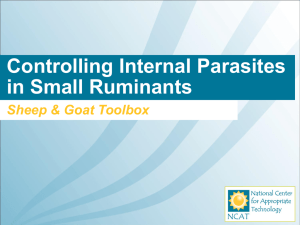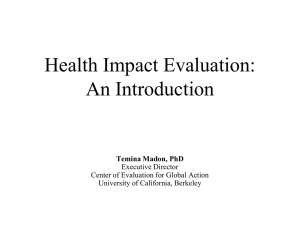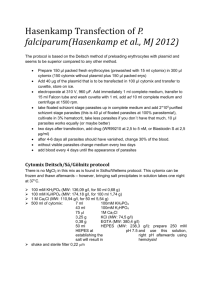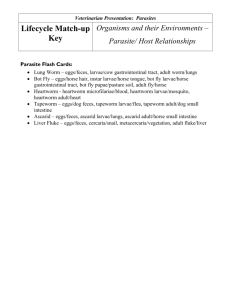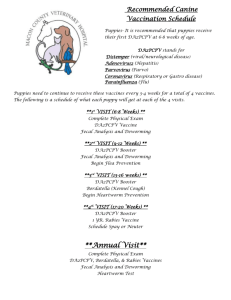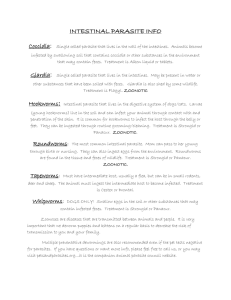Goat Parasites
advertisement
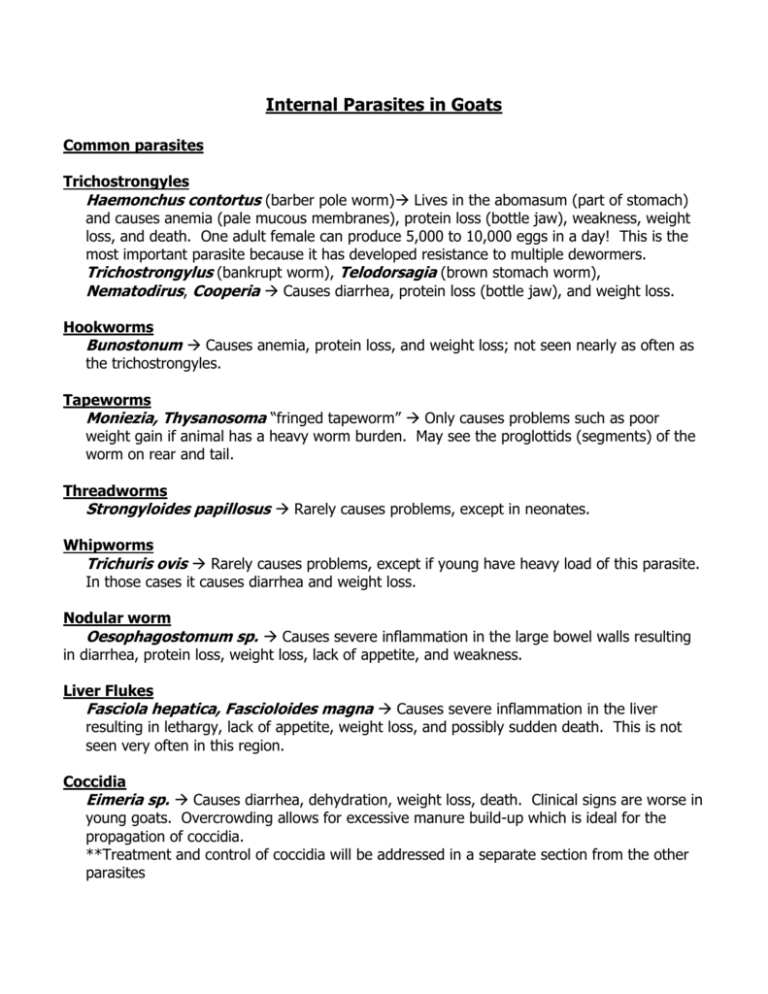
Internal Parasites in Goats Common parasites Trichostrongyles Haemonchus contortus (barber pole worm) Lives in the abomasum (part of stomach) and causes anemia (pale mucous membranes), protein loss (bottle jaw), weakness, weight loss, and death. One adult female can produce 5,000 to 10,000 eggs in a day! This is the most important parasite because it has developed resistance to multiple dewormers. Trichostrongylus (bankrupt worm), Telodorsagia (brown stomach worm), Nematodirus, Cooperia Causes diarrhea, protein loss (bottle jaw), and weight loss. Hookworms Bunostonum Causes anemia, protein loss, and weight loss; not seen nearly as often as the trichostrongyles. Tapeworms Moniezia, Thysanosoma “fringed tapeworm” Only causes problems such as poor weight gain if animal has a heavy worm burden. May see the proglottids (segments) of the worm on rear and tail. Threadworms Strongyloides papillosus Rarely causes problems, except in neonates. Whipworms Trichuris ovis Rarely causes problems, except if young have heavy load of this parasite. In those cases it causes diarrhea and weight loss. Nodular worm Oesophagostomum sp. Causes severe inflammation in the large bowel walls resulting in diarrhea, protein loss, weight loss, lack of appetite, and weakness. Liver Flukes Fasciola hepatica, Fascioloides magna Causes severe inflammation in the liver resulting in lethargy, lack of appetite, weight loss, and possibly sudden death. This is not seen very often in this region. Coccidia Eimeria sp. Causes diarrhea, dehydration, weight loss, death. Clinical signs are worse in young goats. Overcrowding allows for excessive manure build-up which is ideal for the propagation of coccidia. **Treatment and control of coccidia will be addressed in a separate section from the other parasites Life Cycle of Haemonchus contortus: While the life cycle of other parasites is important, Haemonchus is our primary concern, so it is useful to understand its life cycle when developing a control program. The adult worm lives in the abomasum (one of the stomachs) where they attach and suck blood. Eggs are laid and are then passed in the feces. Eggs hatch into the 1st stage larvae and then mature to 2nd and 3rd stage larvae in the pasture. 3rd stage larvae migrate up blades of grass where the goats ingest them as they graze. The larvae mature to adults in the goat and the cycle begins again. Control of Parasites: Depending on the number of animals, acreage/lot size, and history of parasite control, deworming recommendations will vary from farm to farm. Resistance to dewormers has become a major problem in goats. Haemonchus, in particular, has become resistant to many dewormers in various regions of the U.S. It is important to keep in mind that parasite control involves more than just deworming your goats. The goal in controlling parasites should not be to get rid of every single parasite but to decrease the population of parasites so that they do not cause serious herd problems. Minimize fecal contamination of feeds. Don’t place feed on the ground and keep feed troughs cleaned out. Deworming too often is one of the major causes of parasite resistance to dewormers. o When questioning the efficacy of a dewormer, it is helpful to get a fecal sample prior to deworming and then collect a second sample 2-3 weeks after deworming. We can perform a fecal egg count. If the dewormer is effective there should be a 90-95% reduction in the number of eggs. Isolate new animals that are brought onto the farm. These animals need to be dewormed and then have the feces checked for parasitic eggs 2 weeks after deworming. Once they are clear of parasites, they can be mixed with the rest of the herd. Isolation is a good practice to follow to prevent other diseases as well. Be sure to use the appropriate dose of dewormer. Underdosing is not only ineffective, it can also lead to resistant parasites. Pasture management- “The solution to pollution is dilution.” o This phrase holds true for parasite control in any species. Parasites are going to be a bigger problem when you have lots of animals in a small area. The ideal stocking rate for goats (or sheep) is 6-8 animals per acre of land. o Most of the worm burden is found in the pasture. Here are a couple of ways to decrease the amount of larvae in the pasture: There will be some larvae that will survive the winter in the pasture. About 3 weeks after the animals have been on the spring pasture, deworm them all. This will kill the worms that the goats have gotten from ingesting the larvae that survived the winter. This may need to be repeated 1-2 more times 3-4 weeks apart. If you have access to multiple pastures, you may be able to use a pasture for weeks to months before the larvae build up on the pasture. Then you can deworm the herd and rotate them to a new pasture. This is referred to as a treat and move strategy. Rotating animals on a pasture can also decrease the larvae contamination. Rotate the goats with another animal, like cattle or horses. Do not rotate with sheep because they have the same parasites. FAMACHA This a salvage deworming program. It only works to control Haemonchus infestations. It is a process where the color of the inside of the lower eyelid is compared to that on a chart. Those with a pale mucous membrane color are the animals that are treated. The program was developed to minimize the number of animals being dewormed so that resistance was less likely to be a problem. Keep in mind this entails some strategic planning and time to examine each animal. For more information, please visit this website: http://www.scsrpc.org Deworming on a schedule o Scheduled deworming is not the most optimal for preventing the development of resistant parasites; however for many clients, this is the most practical. o Keep in mind that these are rough guidelines, we can make adjustments according to your herd’s individual needs. Deworm every 3 months. Most of the time use cydectin. Every 3rd deworming use either panacur, safeguard, or valbazen rather than cydectin. 2-3 times a year or whenever a parasite problem arises, bring in a few fecal samples prior to deworming. Then bring in a few fecal samples 2 weeks after deworming. This helps us to tailor a deworming program best suited for your herd. ***Most research suggests that you should use one dewormer until it is no longer effective. The one problem with that is there are some parasites that may not be killed by a particular dewormer. Our practices have found that a large majority of Haemonchus parasites are resistant to ivermectin; however do not discount the benefit of ivermectin for controlling other parasites. Coccidia Coccidia is a unique protozoal parasite that can be devastating in a herd. It is a common cause of pasty to watery diarrhea in kids. Other signs include dehydration, lack of appetite, weakness, rough hair coat, and death. Disease becomes worse when the goats are stressed (by shipping, weaning, or feed changes). Coccidia are transmitted by ingesting feces that contain coccidia. The coccidia destroy the cells lining the intestinal tract as they reproduce inside the animal. As with the other parasites, “the solution to pollution is dilution”. Too many animals in a small area will contribute to the severity of coccidiosis. Coccidia do not survive well in dry conditions with direct sunlight. Diagnosis of coccidia is by submitting a fecal sample to be examined under a microscope. Treatment/Prevention: Drug Lasalocid Trade Name Bovatec Dose 20 30 grams per ton of feed 0.5 lbs per ton of feed Comment Used for prevention of coccidia Used for prevention of coccidia Decoquinate Deccox Monensin Rumensin 15-20 grams per ton of feed Used for prevention of coccidia Amprolium Corid Drench: 9 mls/50 lbs body weight for 5 days straight In the water: 4 oz of corid per 5 gallons of water. Give as only water source for 5 days straight 24 hour meat withdrawal; 96 hour milk withdrawal
